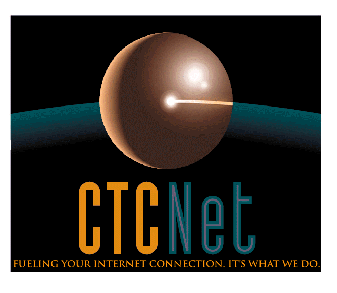Frozen out: 25 years of broadband failure in rural northern Wisconsin
Introduction
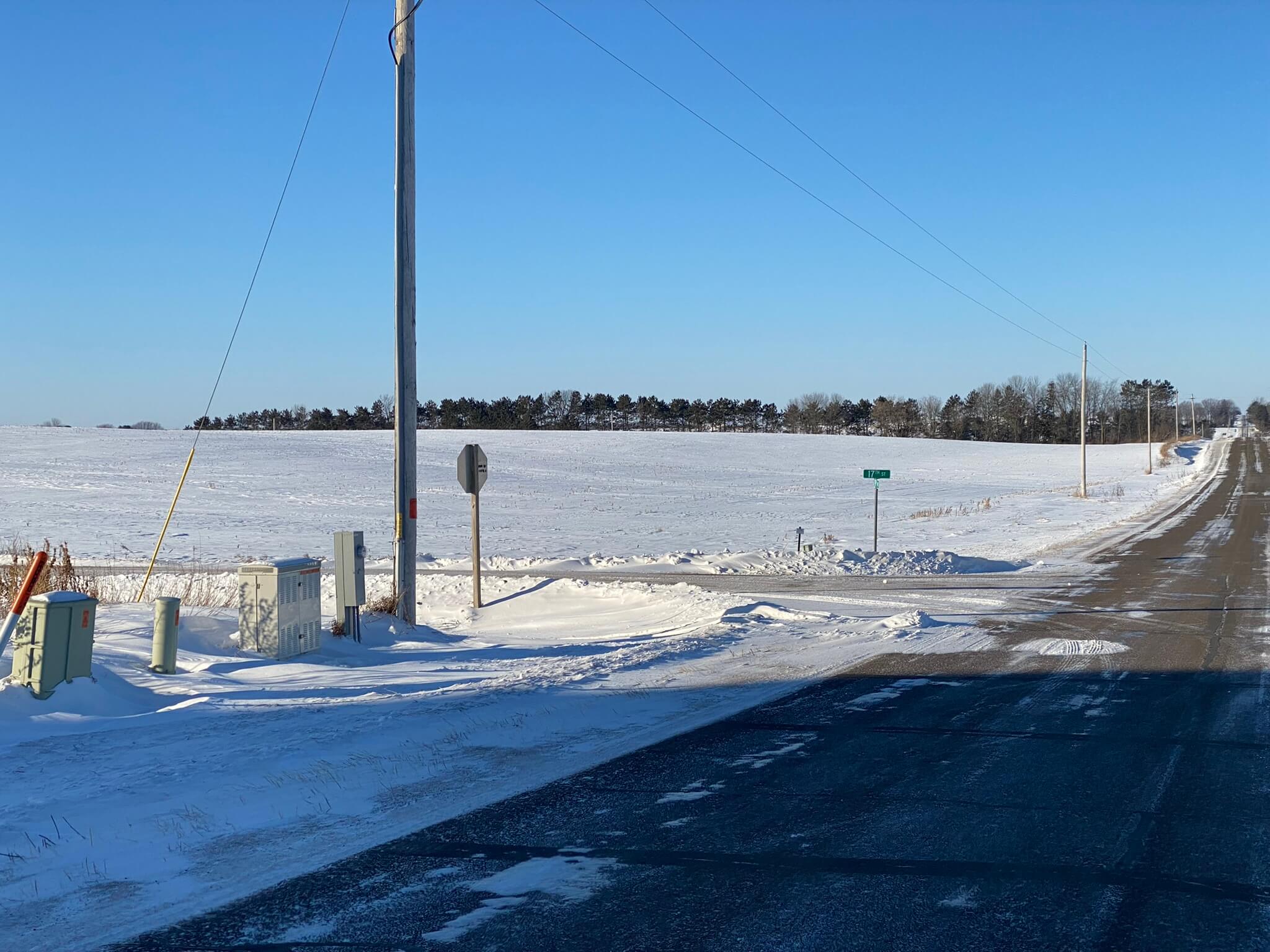
This past Christmas I realized it’s now been exactly 25 years - 1996 - since my parents got the Christmas present that would change my life forever: a Gateway 2000 home computer.
Up to that point in my life I hadn’t given much thought to computers. It wasn’t something that many people in my area had, growing up on a dairy farm in rural northern Wisconsin.
Little did I know that computer would change the trajectory of my entire life and turn me into the computer programmer that I am today.
Today, of course, the world has shifted and now everyone has a computer in their pocket at all times, even in my rural hometown.
Even when I went to high school in the mid-aughts the only course centered around computers was a typing course, which was practically just ported over from typewriters: here’s a business letter; re-type it as fast as you possibly can without making mistakes. I showed my instructor my Red Hat Linux t-shirt, and she had no idea what I was talking about - the course may have used computers, but it had nothing to do with computing.1 Today, I hear they have programming and robotics courses - how cool is that.
And yet, the crazy thing is that while everybody back home has the latest computing devices, I know there are many households that don’t have the broadband internet capability to make them very useful. My parents’ house is one of them - their internet connection is hardly better than the dial-up they had 25 years ago!
Broadband internet is a utility
Before the pandemic, my nephew, who lives near my parents, would often have to stay late after school to complete his schoolwork that required decent internet. Terrible.
Then, the pandemic came. Early on I would sometimes have to check in on my eldest daughter, glancing over her shoulder as she attended her classes remotely. It was obvious some kids in her class were not fully able to participate. I remember one bright-eyed kid with a smirk trying to get a comment in during a class whose video and audio came through so garbled - even after they turned off their video - and with the teacher telling them repeatedly they aren’t coming through until they were just shut down completely. That was heartbreaking.
Adults had the same issue during the pandemic with the massive shift to remote work. My mom couldn’t attend remote meetings because of her junk home internet. Sometimes she could squeak by after disabling video, but even audio-only was unreliable enough that she just gave up. Even before the pandemic, work across the country has been steadily shifting towards remote for a ton of reasons.
How can rural communities stay competitive if we can’t learn and work remotely?
That’s not to mention social media being the new public commons, for better or worse. Twitter and Facebook are where many of our fellow citizens discuss news and politics. Kids socialize on TikTok, Instagram and wherever else.
How can rural communities maintain a voice if we’re unplugged from the public commons?
I could go on and on - everybody shops online now, etc. - but it seems obvious to me: broadband internet is a utility, a necessary part of our infrastructure the same way electricity is.
My personal broadband struggle
The frustrating thing to me is, while the pandemic may have greatly exacerbated the issue, this is something I’ve personally felt the pain of for over 20 years.
Take a walk with me and I’ll show you what my internet journey was like from the very beginning (and if it gets too monotonous you can jump to the end using the table of contents).
1997: 56Kbps Dial-up - my introduction to the internet

It’s hard to imagine now, but when we got our computer in 1996 when I was 10 years old, we had no thought of internet access. We didn’t even know what “internet” was.
Our computer in fact worked just fine as a standalone device - it ran Windows 95 with some preinstalled programs, and we had separate CD-ROMs and floppy disks for running certain other programs like video games, Encarta encyclopedia, etc.
There were no security updates, or any other constant stream of updates to be installed. When it was time to upgrade a piece of software - or even the entire operating system - we bought a new set of floppies or CD-ROMs.
If I wanted to share, say, something I had typed up in Office 95’s word processor, I’d either print it out on our inkjet printer or save it on a floppy disk to physically take to another computer.2
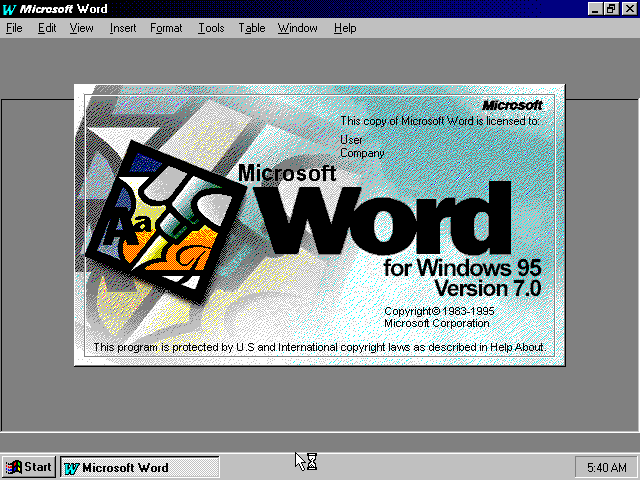
It wasn’t until the next summer as I recall that my parents figured out how to get set up for internet access via dial-up through the local telephone coop, Chibardun.
We had to install a modem3 into our computer (opening your computer was a scary prospect back in those days!), plug a telephone cord into it, and got instructions from our ISP how to dial in. That process looked something like this:4
It was a great time to be on dial-up as that’s what most households had5, so most websites were built for that experience.6 I played Starcraft and Diablo with other people online; I could even play certain first-person shooters (FPSes) like Team Fortress Classic if I restricted my class selection to roles like or sniper or engineer, which didn’t require the low latency needed to win close-range gunfights.
Gaming is probably where my first interest in the low levels of computers, and thus programming, was born. My brother Noah and I used to play the heck out of a game called Interstate ‘76; it was a game where you drove armored cars with guns attached, and had to shoot / blow up other cars. The game also came with an online play mode, where you could gear up your car and go and fight other peoples’ car builds.

It was in this online play mode where I saw all kinds of crazy car paint jobs and modded models which were not something you could get in the base game. Back in those days there was no Google or YouTube to lead you to how to figure it out on your own. Instead some folks in the in-game chat gave me links to some hobby Geocities or Angelfire websites where people explained how it was done.
What that involved was downloading a hex editor, and modifying certain game files at specific offsets to change values to upgrade weapons, armor, and even the paint jobs. This was some amazing wizardry to me at the time.
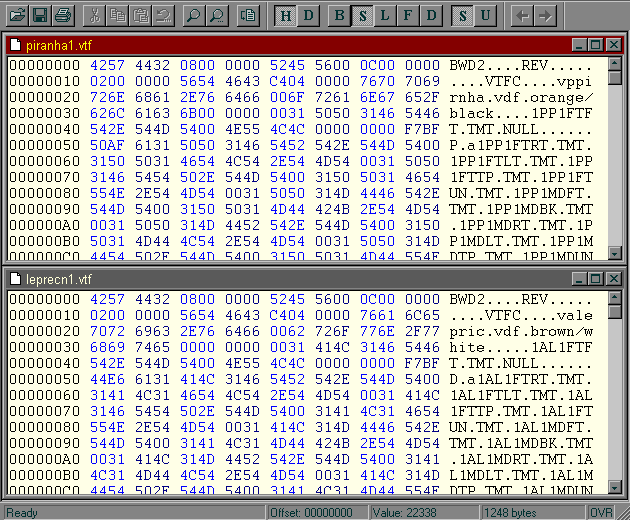
There were other game hacks too, like the legendary BoBaFeTT’s trainer for Diablo, that led me to an interest in poking memory values with programs like SoftICE. Learning to poke binary bits led me to relevant articles like “Smashing The Stack For Fun And Profit”, which at the time I couldn’t make sense of but reading it made me feel 1337. It got me interesting in “hacking” and how computer software works under the hood.
It also led me to make my first website to share my hacked game files, on the free web host Angelfire (Geocities was the other popular one). Mainly by looking at HTML of existing pages I liked, and editing in Notepad or Wordpad. Borrowing images and even creating some of my own in Paintshop Pro (by following some tutorials).
I digress, but needless to say there’s a direct line from these experiences to my career as a programmer today.
1999: my friends get broadband
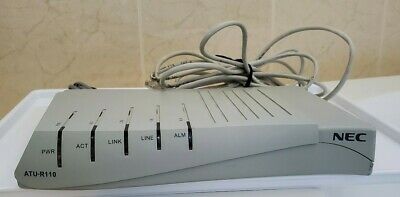
Around 1999 or so, my friend Tyler who lived in “the city” got symmetric 512kbps/512kbps DSL broadband from the same ISP I got dial-up from (Chibardun). DSL as a technology uses the same telephone copper as dial-up, but if you are close enough to the ISP’s central office (or a fiber-fed DSLAM cabinet) then you are able to get much faster speeds by cranking up the line frequency.
I used to pack up my desktop PC and drive to his house, where we’d have Counter-Strike gaming sessions late into the night. Eventually he’d fall asleep, but I’d stay up all night busily downloading all the hefty stuff that would normally take me weeks to download at home.
Sometimes my other friends would go to his place with their PCs and we’d have LAN parties, playing Counter-Strike or whatever other games we were into at the time.
This is when I first saw the light of what the future internet would look like, and how important broadband would be in order to participate in it.
It was also around this time that I typed up letters that I mailed to both Charter and Chibardun begging them to please provide broadband at our farm. From then on every time I’d see utility equipment digging anywhere near my road I’d get all excited that they might be burying cable to get us high-speed internet!
At this time, in middle school, a lot of my classmates were on ICQ, an early instant messenger:
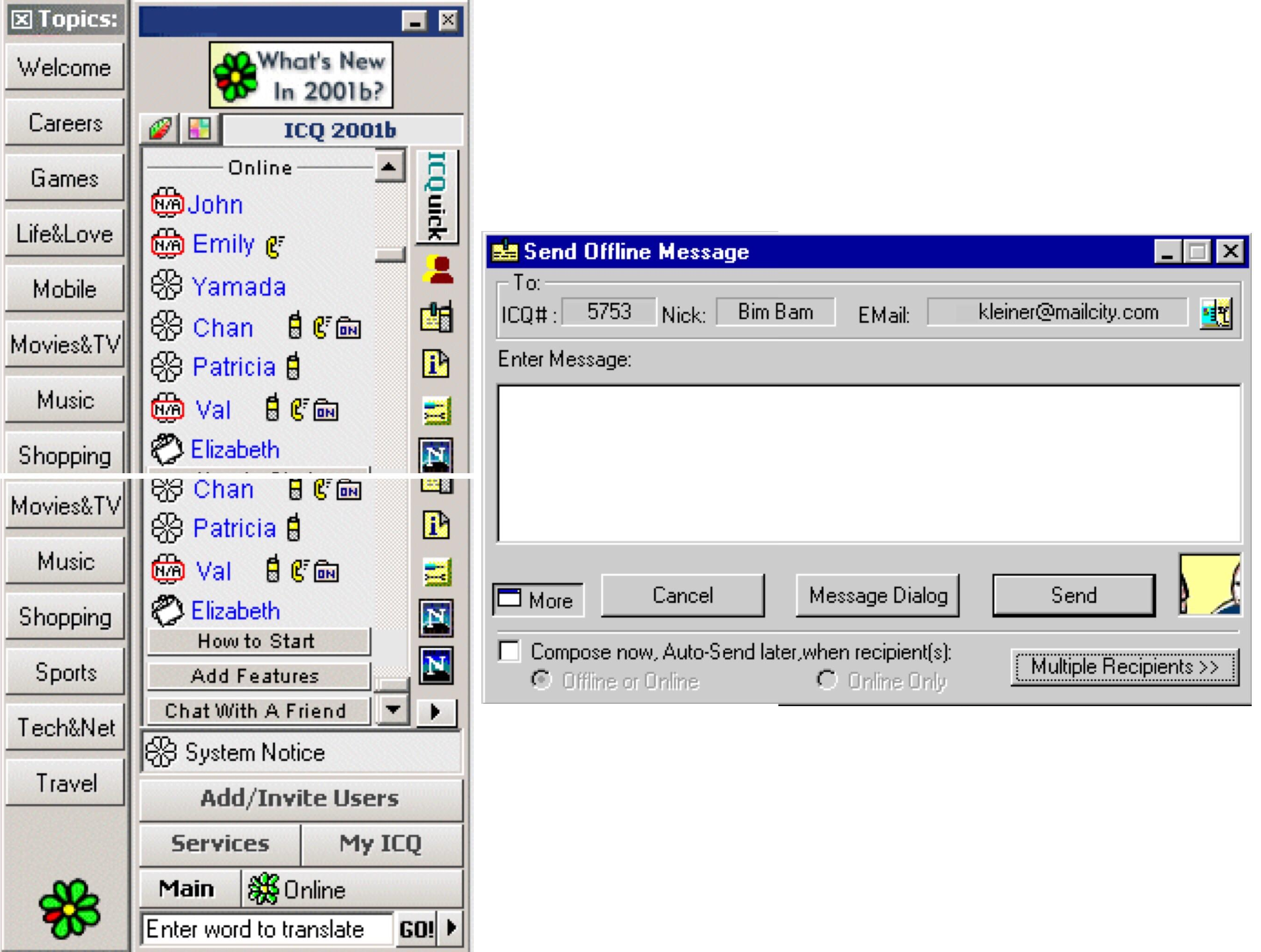
There was no central directory of people, or suggested friends, and nobody used their real names, but just by everyone manually sharing contacts by numeric ID there were a lot of peers you could chat with.7
My friends and I loved to prank classmates by sending them custom-built trojan files over ICQ, and when they opened them - few people had antivirus back then - we’d get complete remote control over their computer and could move their mouse around, open their CD-ROM drive, view their webcam, play audio files, navigate their web browser to certain websites, etc. It was pretty funny for some juvenile entertainment, and we never did anything harmful like delete files. And then my classmates thought I was a 1337 h4x0r.
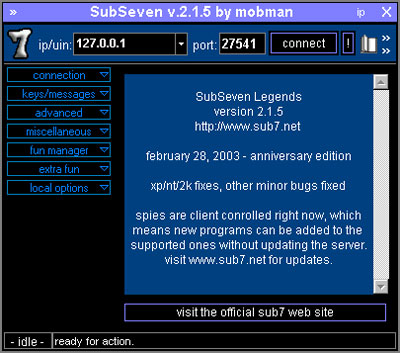
2003: 3-10Mbps 2.4GHz WISP
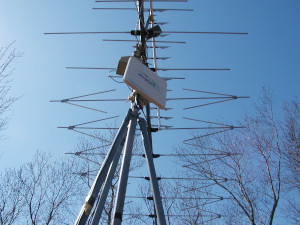
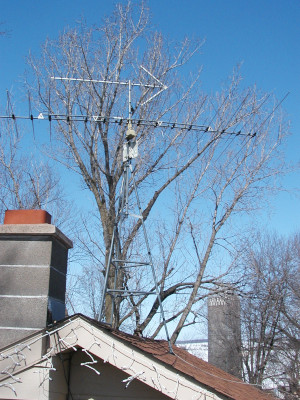
We suffered through the dial-up for several years until we found a small business in town, DCS Netlink, that was running a wireless ISP (WISP). They came out and did a preliminary site survey and believed they could hook us up. Their proposal was to put their antenna on our house roof and point it through some trees to reach the base station on the radio tower they were using.
I knew that would likely have interference which would decrease our speeds, so I requested they put the antenna on top of one of our silos. They told us they couldn’t do the silo install as they were worried about combustible gases coming out of the silo that could set off an explosion. Even if we signed away liability they didn’t want to do it. So we agreed to the roof install.
Soon after they came out and did the install on the house roof as they had planned. The RSSI signal they got by pointing the antenna through the trees was acceptable but not great - think two or three bars on your cell phone out of five. In any case, we now had broadband, although it was typically in the 3-4Mbps range as I recall, sometimes peaking higher. Much better than dial-up but not as good as cable internet you’d get in the city at this point which was over 10Mbps.
Around this time I also became active on DSLReports (also known as BroadbandReports), a web forum where people in the broadband industry as well as spergy dilettantes like myself would go to share news and information about all things broadband and ISP.
This new WISP situation got me excited about doing ISP-type of things on my own, so I did a lot of research on WISPs there and drooled over the posts of people that were starting their own WISPs and getting advice from other forum members. I learned some tidbits about setting up long-range wireless networks, including RF things like calculating Fresnel zones, choosing the right frequency for different environmental attenuation, being wary of reflectivity of nearby landmarks like water towers, things like that. I even worked up the courage to frequently climb our 90-foot silo, which normally gave me jello legs, to run cable up to the top and even install a Yagi antenna up there (I can’t remember for what purpose).
I also did some research on DSLReports about the customer premise equipment (CPE) our WISP was using, and was able to track down a copy of the Windows laptop installer software the techs used. That let me connect to their CPE equipment and view diagnostic info on it and whatnot.
This research gave me the confidence to decide to move the CPE equipment on my own to somewhere where we’d get a better signal. So I ordered a big spool of outdoor-rated, armored gel-flooded CAT5e cable, and strung it across the roof of my parents’ house, across to a machine shed on the other side of the driveway, and then down and just passed the trees that were blocking the signal. I put the antenna up on a ground-mounted tripod to get it up off the ground.
It worked! Now we were in business - we were getting a full four to five bars of RSSI, and speeds more like 8-10Mbps. At this point I started queuing up a bunch of things on BitTorrent that I had been putting off downloading and let it run on my computer overnight.
The next day, while I was at school, apparently around lunchtime some guys from DCS Netlink showed up because they remotely noticed a significant jump in signal quality from our antenna, and they were curious what had happened. My parents said they were mighty impressed with my handiwork and said that I should think about coming to work for them later!
According to my parents, not too long after they left, they came right back, took their antenna down off my tripod, and disconnected our service. Apparently my use of BitTorrent caused some kind of packet storm and knocked their whole system offline for everyone on that tower! They had no interest in reconnecting us even if I promised to be a good boy and never use BitTorrent again.
2004-2005: Wardriving and high school sneakernet

At this point I only had a couple years left to go before finishing high school and going to college, where I would have no problems getting broadband. So I was just biding my time until then.
In the meantime, I bought an awesome Alienware laptop, and an Orinoco Gold 802.11b Wi-Fi card to go with it. I also got an external omnidirectional antenna for it with a magnetic base. This allowed me to drive around the city with my laptop, stick that antenna on my car roof, and look for open Wi-Fi networks using a program called NetStumbler that I could connect to and use for internet access. Literally just driving around slowly, sniffing for open Wi-Fi networks, and then parking in front of a house and borrowing their internet when I got a good signal (being careful to not stay too long and draw attention).
In those days this was called “wardriving” (an homage to wardialing), and it was quite easy back in these early days of Wi-Fi as home routers invariably shipped with a default setting of open, unencrypted Wi-Fi networks, and most people didn’t bother setting up WEP encryption.

Unfortunately I showed this trick to my older brother, who borrowed my gear to download some stuff but didn’t have very good discretion and parked out in front of some rich person’s house for a few hours without moving. That person called the police, worried that someone was casing their house or something like that. The cops showed up at my parents’ house, and after I explained the situation (the don’t talk to cops video didn’t exist yet), they agreed to let things be if I turned over my laptop for inspection and agreed not to do any more wardriving. Being a stupid kid with my parents leering over me I agreed, and was without it for a week or two until they returned it.
After that experience I stuck with bringing USB thumbdrives to school, and simply using my high school’s internet to do most of my recreational browsing. Unfortunately this would bite me in the ass later as my interests included computer hacking related materials, and my school did not appreciate me downloading nasty things like rootkits to this thumbdrive (they assumed I was running them on their network), nor frequently bypassing their content filter / firewall.
Not too long before graduation I got called into the principal’s office, along with a police officer and their head of IT who dropped a two-inch thick stack of printouts in my lap (apparently this guy’s personal entertainment was watching my browsing sessions in real-time every time I’d login). They threatened serious consequences - including up to expulsion, possible charges - but I somehow I managed to sweet talk my way out of the situation entirely by explaining my internet dilemma and my desire to become a programmer.
2005: 512Kbps Chibardun 700KHz WISP; I leave for college
In the spring of 2005, not long before I graduated from high school my parents got wireless internet service from Chibardun. The service was not very fast - 512Kbps as I recall. It was better than dial-up but by 2005 was still quite slow.
Interestingly, Chibardun wasn’t using the unlicensed microwave 2.4GHz spectrum that we had experienced with DCS Netlink, but rather licensed 700KHz. Licensed spectrum is RF spectrum that you pay the feds for the privilege of reserving for yourself, and nobody else in your area is allowed to use it. That gives you a slice of RF that is (in theory) not full of interference from other devices - which can be a big problem nowadays in certain unlicensed bands, like 2.4GHz given the ubiquity of home Wi-Fi networks that use that frequency.
The lower frequency of 700KHz that Chibardun was using has better ability to pass through trees and other obstacles that give 2.4GHz microwave frequency DCS Netlink was using trouble, but at the cost of less bandwidth capability.
Even still, the installers had trouble finding a good signal, and rather than installing on our roof had to install on a nearby shed and trench a cable over to it from the house:
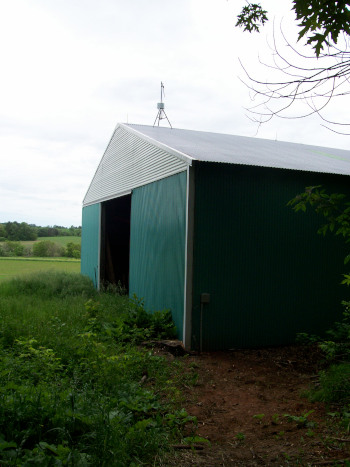
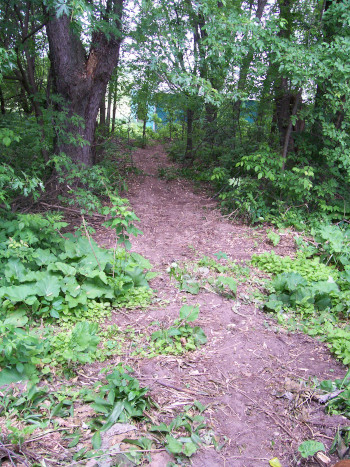
As I recall my parents were still not getting a good signal and having outages with the service. So not long after the Chibardun installers came I bought a higher-gain 700KHz Yagi antenna myself, and moved the antenna and radio to the top of our highest silo:
I’m hazy on how well that worked. I think they still had trouble with it, and they may have not finished the 2-year contract they signed up for given the issues.
That was the spring of my last year of high school, so within just a few months I was moving to the college dorms to pursue Computer Science:

As expected the internet access was amazing compared to anything I’d had before.
Unfortunately it was like mainlining heroin for me and it completely obliterated my discipline to get school work done for the first couple years because the floodgates of the entire internet were finally opened to me - late night Counter-Strike sessions, streaming/pirating all sorts of media, wasting time on YTMND, Break.com, 4chan, Reddit, and so forth.
There ends my personal broadband journey, as every place since college I’ve lived in has had a requirement that it have broadband. To this day that still limits house options, particularly when we moved back to my hometown years later.
My parents and brothers that live nearby still have to deal with limited options, however. So I’m now continuing this log based on their changing internet options.
In 2015 Chibardun Mosaic (at some point around this time they also rebranded) ended up selling their licensed spectrum and got out of the WISP business. In their own words to me via email they did so in order to “go back to [their] roots and stick with providing the very best of buried services.”
2010 (?) to present: CenturyLink 1Mbps DSL
Eventually, my parents were able to technically get DSL at their address via CenturyLink/CenturyTel. I’m hazy on the exact date but I’d guesstimate 2010-ish.
The problem is, they’re so far from a DSLAM that the speeds are terrible. I’m talking 1Mbps. And that is the speed that it remains at to this day, over 10 years later!
By that time, in the year 2010, broadband adoption in the US had jumped to 68% of households (and that’s using the old broadband definition of 4Mbps/1Mbps!). But my parents still were not part of that rarefied group.
2018: Calyx 50Mbps+ LTE
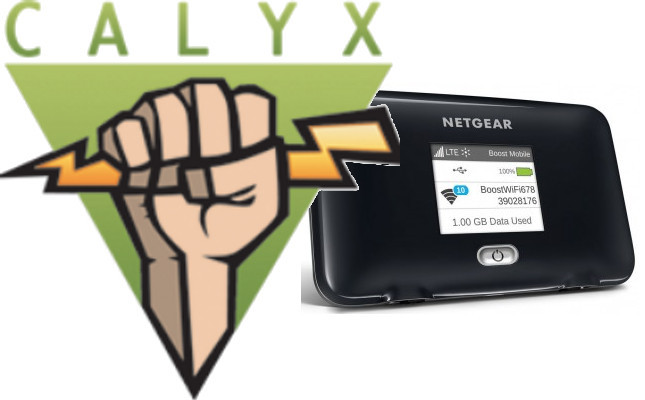
In early 2018 I talked one of my brothers into signing up for Calyx, an interesting nonprofit I had heard about that has an “internet membership” plan where you pay $400-500 per year, and they send you a mobile hotspot that comes with unlimited internet access using T-Mobile and Sprint’s networks. Essentially you are using cellular internet as your primary home internet service.
After getting set up with the service he was able to stream Netflix, YouTube, and basically functionally participate in shared social spaces that the rest of society takes for granted. My other brother also got the service, and more importantly, now my nieces and nephews are able to learn at home and complete their schoolwork without having to stay after school to work (which is what my nephew had to do before then), and are able to socialize online with their peers.
However, it’s not perfect. The hotspot hardware is not meant to be used 24/7 or anything close to it. One of my brothers’ devices overheated and the lithium battery inside bloated up and had to be recycled. My other brother put an electric timer in front of his hotspot to shut it off from bedtime until morning to give it a chance to cool down.
Mobile internet is also not particularly built for home usage. Mobile data traffic is shaped differently by the mobile ISP than home internet providers and it will prioritize cellular traffic. For instance, I played Warzone with my nephew (a latency-sensitive FPS game), and I could tell he was suffering from some jankiness compared to what I get from my cable internet.
I also don’t think this is a sustainable answer if everyone living in the country were to find out about it - if there was massive adoption, I expect the mobile providers would cut Calyx off or adjust their agreement as their towers would be way oversubscribed for the cellular traffic they normally provision them for handling.
There’s also the issue of RF signal - there will always be some places that for various reasons will get poor RF signal quality.
Still, this (and possibly Starlink, which I have no experience with) are probably the best bets for people in rural areas with no other broadband option today.
2018: 1-40Mbps CenturyLink CAF II DSL expansion
In 2018, CenturyLink spent federal Connect America Fund (CAF) II funds to expand broadband access in my hometown. Driving around the countryside you could find utility equipment all over, plowing fiber to newly-built pedestals (presumably with DSLAMs in them to shorten copper loops to customers)!
Was pretty cool to visit family this weekend and see a new telco cabinet, already-ducted boreholes, and markings for a planned fiber route nearby. Things I dreamed of seeing when I was a kid. The farmers are excited they could (finally!) have broadband soon pic.twitter.com/IeFkjAFKXb
— Abe Voelker (@abevoelker) June 11, 2018
In fact one of these pedestals (peds) was put in only 1,500 feet from my parents’ house (and even closer to my brother’s house). My mom asked the utility workers what kind of speeds to expect once the equipment gets turned up and they told her 10Mbps (conveniently 10Mbps/1Mbps is the minimum requirement to provide service in exchange for the CAF II funds). I did some googling around that time and read about tech like G.fast that could provide 100Mbps-1Gbps over short twisted pair copper, and I was sure they were about to get a massive broadband upgrade.
Disappointingly, three years later my parents and brother say their DSL speed has not changed at all from the 1Mbps they were getting before the pedestal was installed. For this reason I had thought for quite a while that the whole thing was a scam, but in the past six months I’ve talked to two people in the community who are getting 30-40Mbps thanks to these new peds, so I think it must be a bad/incomplete ped or some kind of misconfiguration in my parents’ area.
However, I also spoke to a utility worker at a local telecom conference who told me they did some of the construction work on these pedestals and they know of many in a different city that are either empty inside or unpowered (I forget which) and so incomplete and not working!
In any case, CenturyLink Lumen (they rebranded in 2020) has since decided it’s not that interested in rural consumer internet, and has decided to sell its copper in Wisconsin and 19 other states to a company called Apollo. Imagine how sweet of a deal that is - the gov’t pays you to build out monopoly infrastructure that you can either hold onto and charge tolls to use, or turn around and sell for a tidy profit as you see fit!
Imagine if we built roads this way - pay some construction company to build a highway, then this company gets to keep the highway afterward and charge tolls! Insane, no? Yet that’s been the broadband funding model for quite some time, in my estimation.
Searching for solutions
So ends the miserable history lesson of broadband access from the point of view of one rural parcel over the past 25 years.
The question then is, how to fix it?
2016-2018: the micro-ISP daydream
My first inclination was pondering how realistic it would be for me to solve the problem myself - starting a micro-ISP from my parents’ house, spider-webbing out to any interested neighbors to subsidize the cost of the network. Growing up on a farm, it seems like a reasonable thing to do - just put my head down and plow (fiber) baby, plow. Seems to work pretty well for fieldwork.
My first stab in the dark was in late 2016 when I contacted Charter (now Spectrum) to give me an estimate on what it would cost to get a fiber connection to my parents’ house. Some months later they responded with a site survey that described the cost to connect to their nearest “lit building” (a building with lit fiber access), which would require 12,500 feet of outside plant fiber, would come in at $88,082.33!8
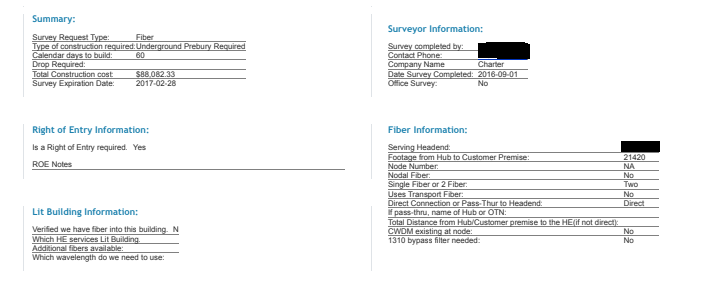
That burst that bubble for a while.
Later, I realized that my site survey with Charter was not what I needed, and that I didn’t even know how to ask the right questions to ascertain the feasibility of my idea. So in 2018 I paid a consultant I found on DSLReports to help me figure out where to buy transit (the backbone bandwidth to power the micro-ISP).
He helped me get quotes from both CenturyLink and Charter that made more sense for what I was trying to achieve - namely just getting the cost of transit from the nearest lit building, and I could separately figure out how to get that connection to my parents’ house, and further to the rest of the neighborhood. I could do that either cheaply, with a wireless point-to-point link from the lit building’s roof to my parents’ place, or very expensively (tens of thousands of dollars per mile) with a new fiber build.
From the quotes I got back, for a 500Mbps/500Mbps symmetric circuit with Centurylink, it would have costed $1,785 per month with a three-year commitment.

At that starting cost, I would require quite a few neighbors to sign on just to break even. And the population density out there is so low that it would be too expensive to plow fiber to each house for any kind of return on investment not measured in decades (plowing a mile of fiber and hitting 2-3 houses is not very economical!). So presumably it’d either have to be a WISP distribution (at least to start off with), or asking for people to invest a large fixed sum out of pocket to subsidize CAPEX costs. And that’s not even touching on the complexity of providing customer service for connection dropouts, or if there’s some major outage at 2AM, etc. - ISPs are not “set it and forget it” businesses, obviously!
While theoretically possible at that number, I felt I needed to learn more about telecom, and fiber optics in particular, before coming up with a real network and business plan.
2018 and 2022: Learning fiber at the local tech school
In early 2018 I signed up for a fiber optics course (Fiber 301) at WITC (a local tech school), part of a unique program called the Broadband Academy ran by Paul Kostner to increase my knowledge about fiber optic networks. I took the course remotely because at the time I was living a couple of hours away from the school. But I learned all about fiber optic networks, primarily at the high-level design stage, what’s referred to as the “outside plant” in telecom (basically all the cabling that’s buried or strung aerially outside “premises,” or buildings). The final project was to design a real fiber-to-the-X (FTTX) project:
Finished the final project for a tech school course I was taking on fiber optic outside plant / OSP. The project was to design a FTTX network, including the RFP, a project proposal w/ specific products and construction milestones, optical loss budgets, a Google Earth map, etc. pic.twitter.com/lQFx68THyJ
— Abe Voelker (@abevoelker) May 17, 2018
Later, when I moved back home, I took Fiber 201 from the same tech school (since rebranded to Northwood Tech) and instructor. This course is more geared towards technicians on the ground who will be actually working with fiber cables, so I got to get my hands dirty with cutting, splicing, testing the cables, and so on. I learned so much about fiber from these two courses that now I feel confident about being able to work with the cables both in both inside and outside plant operations:
Been taking a telecom class at the local tech school and I’m gonna get to do hands on fiber fusion splicing, testing for faults with an OTDR etc. Pretty rad. There’s another class where you get to operate a directional drill I’m gonna try to apply for in the fall pic.twitter.com/92UfB2TIXZ
— Abe Voelker (@abevoelker) January 19, 2022
Me splicing: Haha fuck yeah!!! Yes!! pic.twitter.com/qGzXv0PZr6
— Abe Voelker (@abevoelker) January 27, 2022
Past couple weeks we’ve been using optical time domain reflectometers (OTDRs) to test for cable faults and get rough loss estimates. It uses backscatter light reflections in the link to plot breaks, connectors, etc. as events in a graph. Pretty cool (but expensive) piece of kit pic.twitter.com/ISVyy9Xkfs
— Abe Voelker (@abevoelker) March 2, 2022
As part of the course we also got to attend a local telecom conference, and hear talks from people in the industry about where things are headed.
Went to a local fiber telecom conference and @CyberSquirrel1 made an appearance pic.twitter.com/yq46UYtvoM
— Abe Voelker (@abevoelker) February 18, 2022
The conference is put on by a conglomerate of telephone cooperatives and I believe was started in the early 1980s when the outside plant cabling was still primarily copper. But there was no talk of copper here; the conference was all about fiber, fiber, fiber - it’s a foregone conclusion that internet will be served to homes via fiber; the only question is how ISPs will feasibly get to the goal.
This inevitability of fiber is backed up by the physics of cabling that I learned about in my fiber coursework. When you push data through a copper cable, the higher frequency data rate you push through the cable, the higher the resistance you’ll get in the cable, and thus the shorter distance you’ll effectively be able to transmit data over the cable.
You can see this clearly in the CAT5/6/7 Ethernet cabling standards. One of the newer Cat6a cables can hit 10Gbps at 500MHz bandwidth, but only over about 50 meters of cable. Cat8, an even newer standard, may be able to hit up to 40Gbps at 2000 MHz bandwidth, but only over 30 meters. Until we have room temperature superconductors, this seems to be the physical reality of copper cabling - the higher the frequency data rate, the shorter the cable length can effectively be.9
Fiber, meanwhile, has a constant rate of attenuation (loss) regardless of the data frequency you’re pushing through the cable. That’s how there can constantly be new data transmission records being broken using long lengths of fiber - the latest being 319000Gbps (319Tbps) over 3000 kilometers of fiber last year.
So it makes perfect sense why fiber is the end solution for home broadband - it’s not unlike when home electrification was first coming out and there were squabbles over DC or AC transmission. When AC won out due to its technical superiority, the only remaining problem was rolling out the winning infrastructure technology to the entire country.
Interlude: rural electrification
Speaking of home electrification, there are a lot of similarities between it and the rural broadband problem.
About 90 years ago, homes in the city were being hooked up to newly-built electric grids, but homes in rural areas were not. In those days in rural communities, kids had to manually carry water into the house from the outside well, clothes were washed by hand on washboards, the house - and barn - were lit by kerosene lamp (or candles), and cooking and heating were done through wood stoves that needed wood to be manually carried in from outside, and the ashes carried back out. One electric item a farm may have had is an electric radio, but those were powered by heavy batteries that needed to be recharged with things like home windmills.
Just like today’s broadband coverage issue, the low population density of rural areas made it too costly for private electric companies looking to make a profit to build out the CAPEX-heavy infrastructure.
Of course, people in the country knew what they were missing out on and were desperate for all the benefits they knew electricity would bring:

Here’s a great video from the 1950s with a lead-in with a farm girl asking her mom why they can’t have electricity, and the way rural communities solved the problem themselves:
Thankfully at that time in 1935 - during the Great Depression - FDR and the federal government created one of its successful relief programs called the Rural Electrification Administration (REA), and soon after the Rural Electrification Act of 1936 to fund it. The program gave out low-cost loans to rural electric cooperatives to provide electricity; this created thousands of new municipal power utilities. The program was very successful: in 1934 only 11% of farms had electricity; by 1942 the number were already at 50%, and by 1952 it was almost 100%.
Rural electrification was a huge advancement for farmers who were quick to adapt to electrified equipment, which replaced a lot of manual labor needed to clean their barns, milk their cows, get silage into and out of their silos to feed their cattle, and so on. Electric lights were also much safer and more convenient than kerosene lanterns. Here’s a video from 1950 that shows the many types of new electric machinery farmers began utilizing:
Today, as the United States continues shifting towards a knowledge economy - of work performed from home on computers - the communications gap in rural communities is not unlike the electrification gap farmers faced almost 100 years ago.
It’s a sad state of affairs that the country was able to swiftly solve rural electrification during a time of crisis and lack of resources, but during more modern times of plenty over the past few decades, the USG’s solutions to broadband amounted to squandering hundreds of billions of taxpayer dollars in corporate welfare to companies that ultimately failed to deliver on their promises and left generations of Americans disconnected from the internet.
2018-2021: Broadband funding and running for county board
Back to my own experiences.
During the time while I was learning telecom tech, I also kept up with broadband news, primarily via the Institute for Local Self-Reliance’s (ILSR) broadband wing, ran by Christopher Mitchell who puts out some amazing content on community-led broadband initiatives. Two podcasts he hosts, Connect This! and Community Broadband Bits, are both fantastic listens about how communities are tackling the broadband issue. I also highly recommend the POTs and PANs blog ran by telecom consultant and industry veteran Doug Dawson - seemingly he puts out an article every day with his insights.
What’s with the EBB –> ACP rebrand? How can rural counties take advantage of broadband funding? All this (& more!) in last week’s episode of Connect This! pic.twitter.com/6MHPrf3Lut
— Muni Networks (@MuniNetworks) January 20, 2022
An important thing I learned from these resources are the different community models for getting these networks built. While I had been thinking of how to solve the problem solely through a private company, often there are public-private partnerships, where private companies work hand-in-hand with local governments.
One thing that kept bothering me thinking about broadband as a market is the monopoly problem. The first ISP that buries fiber to your home is likely to be the last wired ISP you’ll ever have. It just isn’t cost-effective for another ISP to bury their own fiber to your door and hope that maybe, just maybe you’ll switch service to them. That makes about as much sense as having multiple water and septic pipes ran to your house by different water companies, or multiple electric lines. In other words the market is a natural monopoly. For most such services the problem is solved by regulations, but that has not happened for broadband.
Another bothersome issue is taxpayer dollars being spent on these private networks that then fail to deliver, but then private companies still own the infrastructure and stifle competition. As I said earlier, CenturyLink built a fiber-fed, non-working pedestal very close to my parents’ house. In a sane world, this taxpayer-funded fiber would be open access, and I would be able to grab a couple fibers to start a community network. But instead, CenturyLink gets a free check for subpar infrastructure that they were able to sell off for profit.
So in that vein, one interesting case study that piqued my interest I heard about from ILSR that seemed to directly address these problems is what the city of Ammon, Idaho did. They built their own municipal broadband network, but they just own the fiber, i.e. the “dumb pipes” - they don’t own or operate the underlying network (actually moving the bits around). Instead, different private ISPs plug in their equipment at the city’s data center, and using a virtual network, any citizen of Ammon can switch to different ISPs at any time. The ISPs compete on bandwidth, price, and customer service, but not who owns the fiber infrastructure. They call this the “Ammon model:”
There are also municipalities that own and operate entire networks as ISPs (called municipal broadband). This often occurs when there’s absolutely no other option because no private entity will provide decent service. Chattanooga, TN is one excellent example of doing this the right way. They provide Gigabit fiber to their citizens as a municipal service.
There are I’m sure municipalities who do this poorly, and the idea of gov’t-owned internet encroaching on what many see as a market problem, and crowding out free enterprise competition does make some people nervous. But I can’t help but see it as a viable option (starting a cooperative is another, but as I wrote about when it comes to dairy, co-ops are hardly impervious to going rotten).
The municipal-owned model has barriers to being implemented in Wisconsin, so it would be an uphill battle to even attempt this in my community.
Regardless, as a model it doesn’t make much sense for my area, anyway. Municipalities are cities, townships and villages, but when you look at a map of my county - all 800+ square miles of it - there are a few big blobs of cities that have excellent broadband coverage, while all the dozens of outlying townships and villages are in wide swathes of unconnected territory. Each municipality is too small for it to make sense for them to each solve the problem on their own.
Instead, I think a model that is more interesting for my area is in building out county-wide middle mile fiber networks. The idea is a county or municipality (it seems to be increasingly popular with counties) spends grant money to bury fiber as a backbone across a segment of the county. That fiber is considered open access, and can be freely or cheaply leased to an ISP to connect to and provide services from. The idea is it makes it easier for ISPs to provide service to remote customers by shortening spans of fiber that need to be buried to reach them. It makes sense to me to address the issue at the county level given it’s the logical unit of coordination between the various townships and villages.
And in fact, I heard about a Wisconsin county that is already doing this right now: Taylor County.

Excited with the idea, in late 2021 I met with my county executive to discuss the broadband issue generally and feel him out for what he thought about a middle mile fiber solution. He was quite negative about the county getting involved in owning fiber and though it’s a problem best left to the free market. He also mentioned there would be some big news coming out soon that he was not at liberty to discuss in detail but that I would probably be very pleased by.
While curious, I had heard that tune before - like with CenturyLink’s CAF II failure - so I decided to go ahead and put my name on the ballot for county board to see what my potential constituents think we should do.
There are other things I figured the county could do to improve access, too. Like streamlining some processes ISPs follow when interacting with local government when implementing projects (e.g. permitting). In fact there are example ordinances provided by the Wisconsin Public Services Commission (PSC) that could make the county a Broadband Forward! community
So in December 2021 in frigid weather I knocked on dozens of my neighbors’ doors to collect signatures and I got myself on the ballot. Even though I live in a city district where everyone has broadband access, every single person was very receptive to the issue and the county working on some sort of solution.
2022 - Big news drops! Mosaic to the rescue?
Just over a month after getting on the ballot for county board, the big news did break, and it indeed was excellent: our local cooperative, Mosaic (formerly Chibardun), has a plan to build out a fiber-to-the-home network to a good-sized chunk of the county (including my parents’ house)! (The county board’s contribution is to give them a couple hearty pats on the back and well wishes for success, heh)

That’s excellent news, and more or less negated the primary motivation I had for running for the county board. I wrote as much to the local papers when they asked me to provide a little blurb about my reasons for running, so I expect that the incumbent candidate for my district will win the election (he’s a great guy and has been doing it for a long time, so that will be fine by me).
As for what I’ll do instead, my fiber optics instructor has some local contacts where I could potentially do some network planning/construction work if I want to scratch that itch. More likely I’ll be focusing on my programming career though because the market is red-hot right now.
But I’m really relieved that finally - hopefully - this part of Wisconsin will be getting the broadband it deserves!
Footnotes
-
When I entered college, many of my peers from bigger cities came in with prior programming experience from their high school classes. I remember feeling a little intimidated by that, so I’m glad kids in my hometown are now being better prepared. ↩
-
Steeling myself to the not improbable chance I’d discover the floppy was defective when inserted at the destination. I remember my brother’s girlfriend at the time being in tears because she had some huge important essay for a college course saved on a floppy that became corrupt, and there was absolutely nothing we could do about it. ↩
-
Today motherboards have ethernet, audio, USB ports, etc. all integrated into the board, but in my day you had to buy PCI expansion cards, then install a driver from floppy/CD-ROM to add that type of that functionality! ↩
-
Watching this reminded me of how sometimes during the handshake you could anticipate the connection to the ISP wasn’t great just by the sound of the tones. It would just sound “off” somehow. Then sure enough, when the dialing was complete, the little “connected” icon would show an established speed of 28.8kbps. Then you’d disconnect and redial until you’d get a full 56kbps connection. At least, that’s what I did. ↩
-
As of the year 2000 only 4.4% of households had a home broadband connection while 41.5% had dial-up connections. ↩
-
Although it is funny to think back on how many websites used uncompressed .bmp and .wav files! Of course, those were the only formats Windows 95’s Paint and Sound Recorder programs could save. ↩
-
Of course, they wouldn’t receive your message until they came back online (!). ↩
-
The quote included a total cost of $213,332.33 if construction is done during the frost period of October 1st through May 1st! ↩
-
Another alternative is to make the cable super thick, but the amount of power and amplifiers needed to make that work in a long span makes fiber the obvious choice. ↩

